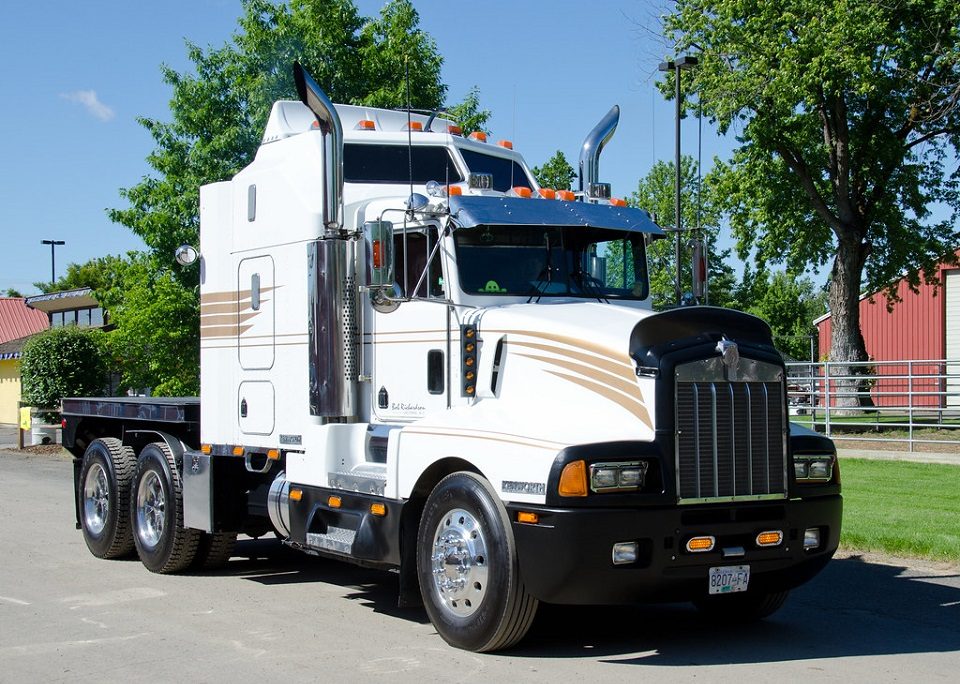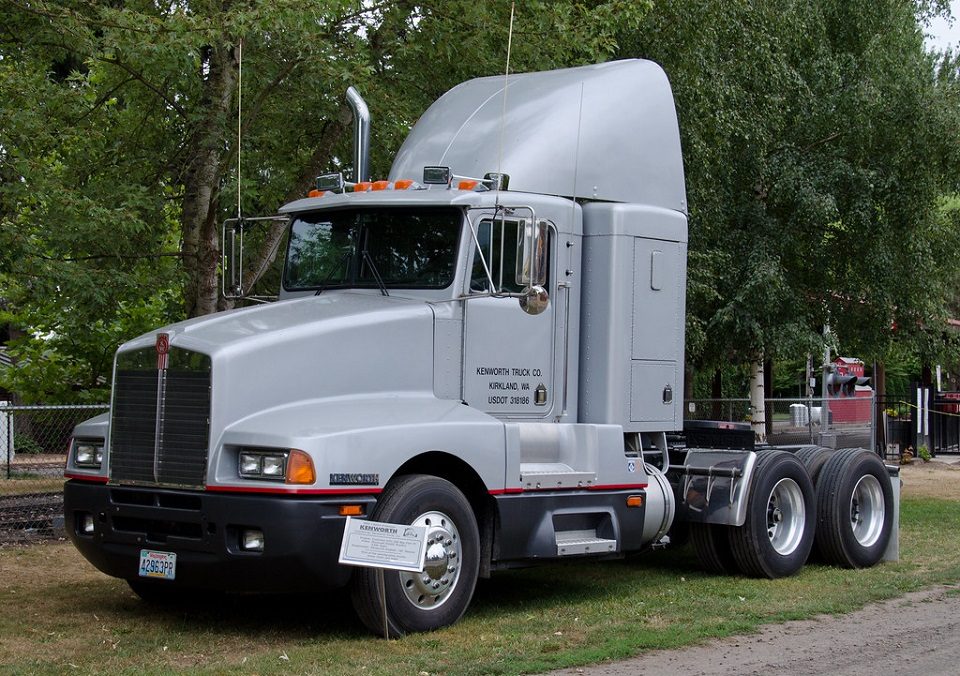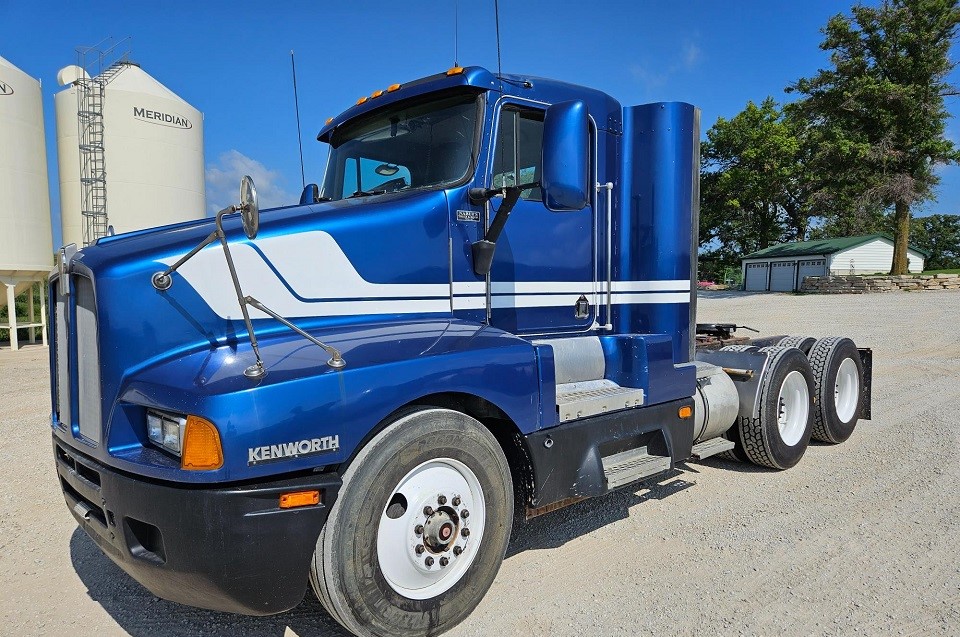Introduction
The Kenworth T600A was introduced to provide a more fuel-efficient and aerodynamically optimized truck for long-haul applications. Known for its distinctive sloped nose and better drag reduction, it pioneered fuel-saving technology in the heavy-duty trucking industry. The Kenworth T600A was designed during an era when fuel efficiency and environmental concerns were becoming critical in the trucking industry. As fuel costs rose and environmental awareness increased, Kenworth introduced the

T600A, the first Class 8 truck to emphasize aerodynamics. This revolutionary design allowed the truck to reduce fuel consumption significantly, making it a pioneer among long-haul trucks.
Historical Significance and Innovation
The T600A was launched when the trucking industry sought ways to cut fuel costs due to the rising prices. Kenworth’s T600A proved that aerodynamic design could save up to 20% in fuel compared to traditional box-shaped trucks, making it a revolutionary model.
Specifications
| Feature | Specification |
|---|---|
| Model | Kenworth T600A |
| Introduction Year | 1985 |
| Engine Options | Cummins, Caterpillar, Detroit Diesel |
| Horsepower Range | 300 – 600 HP |
| Torque Range | Up to 2,050 lb-ft |
| Transmission Options | 10-speed, 13-speed, 18-speed Eaton Fuller, Ultrashift |
| Fuel Efficiency | 10–15% better than traditional trucks |
| Weight Class | Class 8 |
| Suspension Options | Air suspension, leaf spring |
| Cab Types | Day cab, Sleeper cab |
| Brake Type | Drum brakes, optional ABS |
| Wheelbase Options | 160-244 inches |
| Fuel Tank Capacity | 120 – 150 gallons |
| Tire Size | 22.5 inches (varied configurations) |
Read more about Trucks : 2025 Fleetwood Altitude 27U
Key Features of Kenworth T600A
1. Design and Aerodynamics
The T600A’s aerodynamic profile reduced drag, which helped achieve significant improvements in fuel efficiency. The sloped nose and rounded design minimized air resistance, a stark contrast to the square-fronted trucks of its era.
| Feature | Description |
|---|---|
| Aerodynamic Shape | Rounded nose and sloped hood design for reduced drag. |
| Fuel Efficiency | Approximately 10-15% more fuel-efficient than comparable non-aerodynamic models of the time. |
| Other Innovations | Use of lighter materials to reduce weight and further improve fuel efficiency. |
2. Engine Options and Performance
Kenworth offered various engines for the T600A, giving operators choices between power and efficiency. These engine options were from reliable brands such as Cummins and Caterpillar, known for their durability and performance.
| Engine Option | Power Output (HP) | Torque | Manufacturer |
|---|---|---|---|
| Cummins NTC 400 | 400 HP | 1450 lb-ft | Cummins |
| Caterpillar 3406 | 350-425 HP | 1350 lb-ft | Caterpillar |
| Detroit Diesel Series 60 | 350-430 HP | 1400 lb-ft | Detroit Diesel |
3. Fuel Efficiency
The T600A set a new standard in fuel efficiency for heavy trucks. Its innovative design allowed for lower fuel consumption, which translated to reduced costs for operators.
| Aspect | Details |
|---|---|
| Aerodynamic Design | Reduced drag by around 10-15%, enhancing fuel savings. |
| Cost Savings | Helped operators save approximately $1,500 to $2,000 per year in fuel costs. |
| Emissions | Lower emissions due to reduced fuel consumption, contributing to a smaller environmental impact. |
4. Driver Comfort and Cabin Design
Kenworth ensured that the T600A was not only efficient but also comfortable for drivers. It featured an ergonomic interior design, with ample space, good visibility, and adjustable seating for long-haul comfort.
| Feature | Description |
|---|---|
| Seating | Adjustable, high-quality seats for driver comfort. |
| Visibility | Large windshield with reduced blind spots for safer driving. |
| Storage | Ample in-cab storage options for longer hauls. |
| Sound Insulation | Reduced noise levels inside the cabin for a quieter ride. |

5. Comfortable Interior
- The T600A featured an ergonomic cabin with a spacious layout, which was revolutionary for long-haul drivers.
- With various cab options and an enhanced seating arrangement, drivers experienced reduced fatigue on longer routes.
6. Safety Features
The Kenworth T600A integrated safety features that were forward-thinking for its time, prioritizing driver and cargo safety.
| Safety Feature | Description |
|---|---|
| Improved Visibility | Large windows and mirrors for better road view. |
| Braking Systems | Available with advanced braking systems for enhanced stopping power. |
| Frame Strength | Reinforced frame construction for stability and durability. |
7. Comparison with Competitors
The T600A was often compared to other trucks of the late 1980s and early 1990s. Its aerodynamic design and fuel efficiency often made it a preferred choice among operators focused on cost savings.
| Truck Model | Comparison Feature | Kenworth T600A Advantage |
|---|---|---|
| Peterbilt 379 | Fuel Efficiency | T600A had around 10-15% better fuel efficiency. |
| Freightliner FLD | Cabin Comfort | T600A offered better visibility and cabin space. |
| Mack Superliner | Aerodynamics | T600A had a lower drag coefficient. |
8. Improved Maneuverability
- The T600A’s shorter turning radius enhanced its ability to navigate tight spaces, particularly beneficial for urban driving.
- Drivers experienced better handling and greater comfort on long-haul routes
Price Range by Variant
Prices for the Kenworth T600A varied based on the year of manufacture, specifications, and whether it was a new or used vehicle. Below is an estimated price range for different T600A variants:
| Year | Variant | Price Range (USD) |
|---|---|---|
| 1985-1990 | Base Model | $25,000 – $35,000 (used) |
| 1991-1995 | Enhanced Aero Model | $30,000 – $45,000 (used) |
| 1996-2000 | Premium Sleeper Cab | $40,000 – $55,000 (used) |
| 2001-2007 | T600A with ABS | $50,000 – $65,000 (used) |
| 2008 | Final Production Model | $60,000 – $75,000 (used) |
Variants Over Time
The T600A evolved over its production years to meet changing market demands and technological advancements. Below is a table summarizing the major variants and upgrades over time.
| Year Range | Variant | Key Changes and Features |
|---|---|---|
| 1985-1990 | T600A Base Model | Introduction of aerodynamic design, and fuel-efficient engine options. |
| 1991-1995 | T600A Aero Model | Further refinements in aerodynamics, upgraded suspension, improved fuel economy. |
| 1996-2000 | T600A Premium Sleeper | Enhanced interior for driver comfort, improved sleeper cab configurations. |
| 2001-2005 | T600A ABS Variant | Further refinements in aerodynamics, upgraded suspension, and improved fuel economy. |
| 2006-2008 | Final T600A Model | Final production model with enhanced emissions control and updated cabin layout. |
Kenworth T600A vs. Competitors
When compared to other trucks like the Peterbilt 379 and Freightliner Classic, the Kenworth T600A stood out for its aerodynamic efficiency and smoother handling. The following table highlights the differences between the T600A and its key competitors:
| Feature | Kenworth T600A | Peterbilt 379 | Freightliner Classic |
|---|---|---|---|
| Aerodynamics | High | Moderate | Low |
| Fuel Efficiency | 10-15% savings | Average | Below average |
| Engine Options | Multiple | Multiple | Multiple |
| Cab Options | Day, Sleeper | Day, Sleeper | Day, Sleeper |
| Market Popularity | High | High | Moderate |
| Transmission Options | 10-18-speed options | 10-18-speed options | 10-18-speed options |
| Maintenance Cost | Moderate | Moderate to High | High |

Pros and Cons of the Kenworth T600A
The Kenworth T600A brought a mix of benefits and a few challenges. Its focus on fuel efficiency and comfort made it a game-changer, but it wasn’t without minor drawbacks.
| Pros | Cons |
|---|---|
| Fuel-efficient aerodynamic design | Slightly higher initial purchase cost |
| Enhanced driver comfort | Some drivers took time to adjust to the unique design |
| Reliable engine options | Limited color and customization options |
Impact on the Trucking Industry
The T600A’s impact was profound. Its fuel efficiency model forced other manufacturers to rethink their designs, and it inspired a wave of innovation in commercial trucking.
| Industry Impact | Description |
|---|---|
| Fuel Efficiency | Set a new standard, pushing the industry towards more aerodynamic and efficient designs. |
| Innovation Catalyst | Encouraged innovation among competitors in aerodynamics and fuel economy. |
| Economic Influence | Helped operators cut costs, influencing fuel-efficiency expectations across the industry. |
Legacy and Collectibility
Today, the Kenworth T600A holds value among collectors and enthusiasts for its pioneering design and historical significance.
| Aspect | Details |
|---|---|
| Collectibility | High, especially for well-maintained models and unique configurations. |
| Historical Significance | Known as the truck that changed the direction of Class 8 truck design. |
| Modern Modifications | Often restored or customized by enthusiasts, with upgraded interiors and engine tuning. |
Maintenance and Reliability
The Kenworth T600A has a reputation for durability, though it requires routine maintenance to maximize longevity. Parts are generally accessible, and Kenworth’s extensive dealer network supports ease of maintenance.
Resale Value and Market Presence
Even years after its introduction, the T600A holds good resale value due to its fuel-efficient design and reliable performance.
Conclusion
The Kenworth T600A remains a landmark in trucking history, setting the stage for modern aerodynamic semi-truck designs. With its impressive fuel efficiency, driver comfort, and robust build quality, the T600A earned a loyal following. Though it is no longer in production, the T600A’s legacy continues, and it remains a popular choice for used truck buyers looking for reliable, efficient, and comfortable vehicles. Whether you’re a truck enthusiast or a fleet manager, the Kenworth T600A offers a remarkable blend of performance and practicality that has stood the test of time.
Frequently Asked Questions (FAQs)
Q1: When was the Kenworth T600A first introduced?
The Kenworth T600A was first introduced in 1985. It set new industry standards with its aerodynamic design and focus on fuel efficiency.
Q2: Why was the T600A considered revolutionary?
The T600A was one of the first trucks designed with a sloped nose and aerodynamics, resulting in significant fuel savings and improved handling.
Q3: What engine options were available for the T600A?
The T600A offered engine options from Cummins, Caterpillar, and Detroit Diesel, with horsepower ranging from 400 to 600 HP.
Q4: Is the Kenworth T600A still in production?
No, the Kenworth T600A was discontinued in 2008. However, used models are still widely available and popular in the second-hand truck market.
Q5: How much does a used Kenworth T600A cost today?
Prices vary based on the truck’s condition, year, and specifications. Generally, a used T600A can range from $25,000 to $75,000.
Q6: What are some alternatives to the Kenworth T600A?
Alternatives include the Kenworth T660 (its successor), Peterbilt 379, and Freightliner Cascadia, all of which offer various features in the aerodynamic truck market.


